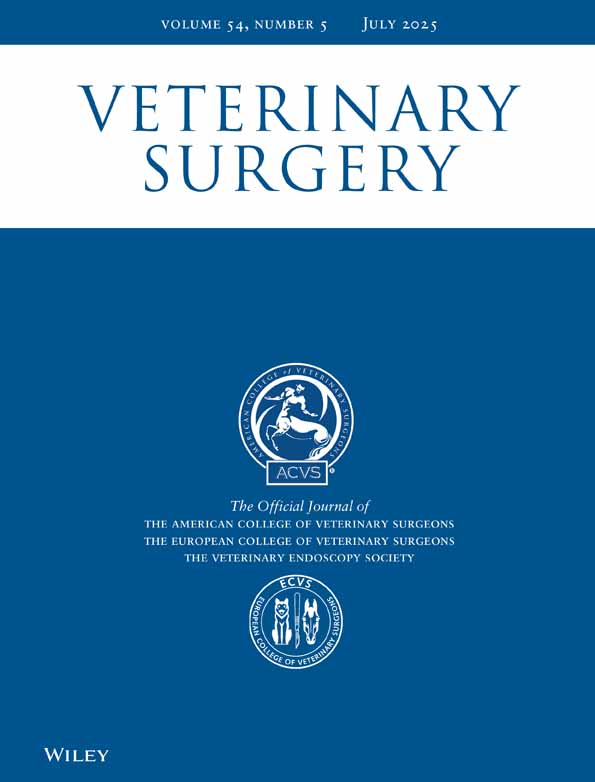Pulsus Alternans During Halothane Anesthesia in a Dog
Corresponding Author
JAMES E. BAILEY dvm
Department of Veterinary Clinical Sciences, College of Veterinary Medicine, The Ohio State University, Columbus, Ohio.
Department of Veterinary Physiology and Pharmacology, College of Veterinary Medicine, The Ohio State University, 1900 Coffey Road, Sisson Hall, Columbus, OH 43210-1089.Search for more papers by this authorWILLIAM W. MUIR III dvm, phd
Department of Veterinary Clinical Sciences, College of Veterinary Medicine, The Ohio State University, Columbus, Ohio.
Search for more papers by this authorROMAN T. SKARDA dmv, phd
Department of Veterinary Clinical Sciences, College of Veterinary Medicine, The Ohio State University, Columbus, Ohio.
Search for more papers by this authorCorresponding Author
JAMES E. BAILEY dvm
Department of Veterinary Clinical Sciences, College of Veterinary Medicine, The Ohio State University, Columbus, Ohio.
Department of Veterinary Physiology and Pharmacology, College of Veterinary Medicine, The Ohio State University, 1900 Coffey Road, Sisson Hall, Columbus, OH 43210-1089.Search for more papers by this authorWILLIAM W. MUIR III dvm, phd
Department of Veterinary Clinical Sciences, College of Veterinary Medicine, The Ohio State University, Columbus, Ohio.
Search for more papers by this authorROMAN T. SKARDA dmv, phd
Department of Veterinary Clinical Sciences, College of Veterinary Medicine, The Ohio State University, Columbus, Ohio.
Search for more papers by this authorAbstract
An adult dog with pyloric obstruction was anesthetized with thiamylal and halothane for surgical revision. When an ECG was attached, the QRS-complex rate was noted to differ dramatically from the peripheral pulse rate. A dorsal pedal arterial catheter was introduced, and direct arterial pressure measurements revealed a blood pressure waveform that alternated in amplitude. Blood pressure and ECG traces were recorded, and the condition was diagnosed as pulsus alternans. The inhalation anesthetic was changed to isoflurane, and the condition was resolved.
References
- 1 Tilley LP. Essentials of Canine and Feline Electrocardiography. 2nd ed. Philadelphia : Lea & Febiger, 1985: 60–64.
- 2 Braunwald E. Heart Disease: A Textbook of Cardiovascular Medicine. 1st ed. Philadelphia : WB Saunders, 1980: 24, 504.
- 3 Alder D., Mahler Y. Modeling mechanical alternans in the beating heart: advantages of a systems-oriented approach. Am J Physiol 1987; 253: H690–H698.
- 4 Hurst JW. The Heart: Arteries and Veins. 3rd ed. New York : Mcgraw- Hill, 1974: 170–179.
- 5 Levine SA. Clinical Heart Disease. 5th ed. Philadelphia : WB Saunders, 1958: 624–625.
- 6 Wood P. Diseases of the Heart and Circulation. 3rd ed. Philadelphia : JB Lippincott, 1968: 313–315.
- 7 Traube L. Ein fall von pulsus bigeminus nebst bemerkungen uber die leberschwellungen bei klappenfehlern und uber acute leber-atrophie. Berl klin Wschr 1872; 9: 185–221.
- 8 Wiggers CJ. Physiology in Health and Disease. 5th ed. Philadelphia : Lea & Febiger, 1949: 574.
- 9 Lu H-H, Lange G., Brooks CM. Comparative studies of electrical and mechanical alternation in heart cells. J Electrocardiol 1968; 1: 7–17.
- 10 Lab MJ, Lee JA. Changes in intracellular calcium during mechanical alternans in isolated ferret ventricular muscle. Circ Res 1990; 66: 585–595.
- 11 Orchard CH, McCall E., Kirby MS, Boyett MR. Mechanical alternans during acidosis in ferret heart muscle. Circ Res 1991; 68: 69–76.
- 12 Sprague DH, Yang JC, Ngai SH. Effects of isoflurane and halothane on contractility and the cyclic 3′,5′-adenosine monophosphate system in the rat aorta. Anesthesiology 1974; 40: 162–167.
- 13 Gelman S., Fowler KC, Smith LR. Regional blood flow during isoflurane and halothane anesthesia. Anesth Analg 1984; 63: 557–565.
- 14 Eger EI II. Isoflurane: a review. Anesthesiology 1981; 55: 559–576.
- 15 Eger EI II, Smith NT, Stoelting RK, et al. Cardiovascular effects of halothane in man. Anesthesiology 1970; 32: 396–409.
- 16 Stevens WC, Cromwell TH, Halsey MJ, et al. The cardiovascular effects of a new inhalation anesthetic, Forane, in human volunteers at constant arterial carbon dioxide tension. Anesthesiology 1971; 35: 8–16.
- 17 Ozak S., Nakaya H., Gotoh Y., et al. Effects of isoflurane on conduction velocity and maximum rate of rise of action potential upstroke in guinea pig papillary muscles. Anesth Analg 1990; 70: 618–623.
- 18 Theye RA, Michenfelder JD. Individual organ contributions to the decrease in whole body VO2 with isoflurane. Anesthesiology 1975; 42: 35–40.
- 19 Marijic J., Stowe DF, Turner LA, et al. Differential protective effects of halothane and isoflurane against hypoxic and reoxygenation injury in the isolated guinea pig heart. Anesthesiology 1990; 73: 976–983.
- 20 Freeman LC, Muir WW Effects of halothane on impulse propagation in purkinje fibers and at purkinje-muscle junctions: relationships of Vmax to conduction velocity. Anesth Analg 1991; 72: 5–10.
- 21 Humphrey LS, Stinson DC, Humphrey MJ, et al. Volatile anesthetic effects on left ventricular relaxation in swine. Anesthesiology 1990: 73: 731–738.
- 22 Komai H., Rusy BF. Direct effect of halothane and isoflurane on the function of the sarcoplasmic reticulum in intact rabbit atria. Anesthesiology 1990; 72: 694–698.
- 23 Wheeler DM, Rice RT, Lakatta EG. The action of halothane on spontaneous contractile waves and stimulated contractions in isolated rat and dog heart cells. Anesthesiology 1990; 72: 911–920.
- 24 Herland JS, Julian FJ, Stephenson DG. Halothane increases Ca2+ efflux via Ca2+ channels of sarcoplasmic reticulum in chemically skinned rat myocardium. J Physiol Lond 1990; 426: 1–18.
- 25 Spear JF, Moore EN. A comparison of alternation in myocardial action potentials and contractility. Am J Physiol 1971; 220: 1708–1716.
- 26 Freeman GL, Widman LE, Campbell JM, Colston JT. An evaluation of pulsus alternans in closed-chest dogs. Am J Physiol 1992; 262: H278–H284.




